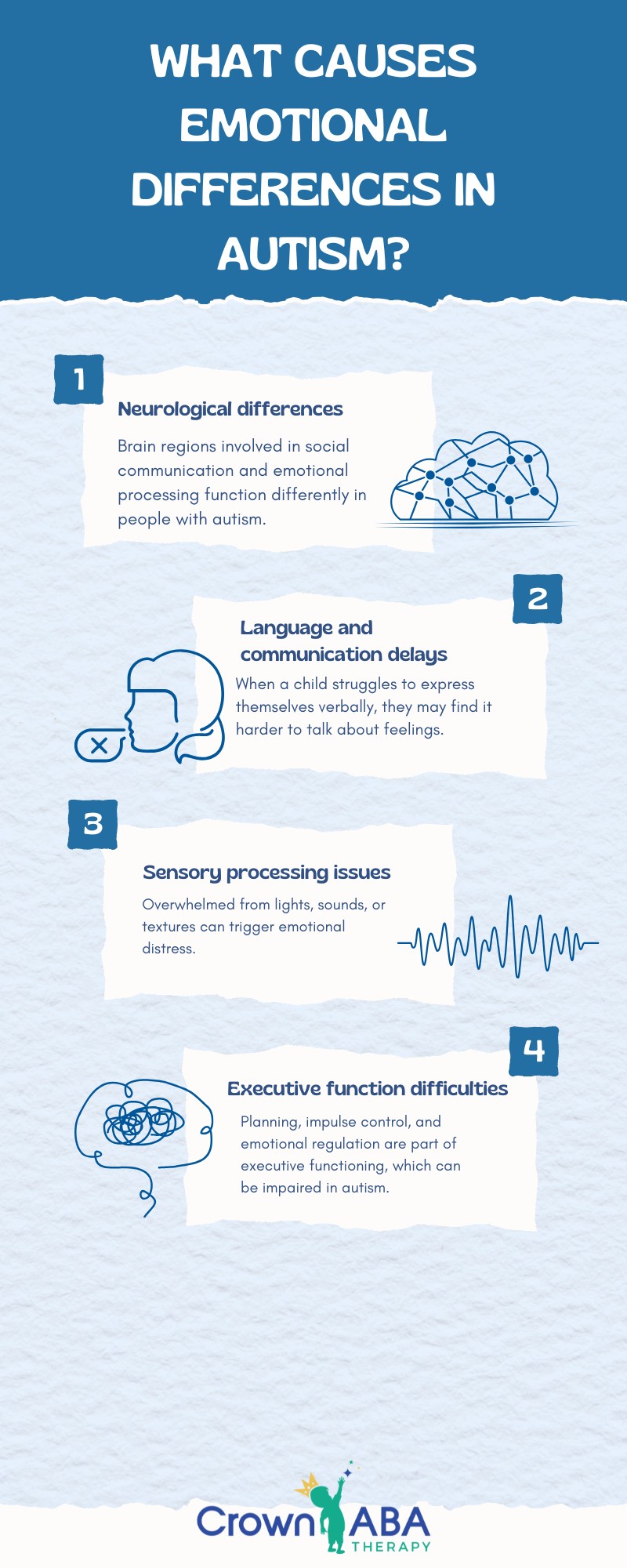Key Points:
- Children with autism often face difficulties identifying, expressing, and managing emotions.
- Emotional challenges in autism can impact relationships, learning, and behavior.
- Parents can use simple, everyday strategies to support emotional growth and regulation.
When raising a child with autism spectrum disorder (ASD), one of the most common concerns parents face involves emotional expression and regulation. Children on the spectrum may struggle to understand their own feelings or the emotions of others, leading to confusion, frustration, and at times, behavioral outbursts.
These emotional challenges aren’t caused by a lack of care or connection, but by differences in how the brain processes and responds to social and sensory input. Understanding the emotional challenges autism brings can help parents become more responsive, patient, and proactive in helping their child grow emotionally.
 Do Children With Autism Struggle With Emotions?
Do Children With Autism Struggle With Emotions?
Yes, many children with autism experience difficulty recognizing, interpreting, and managing emotions—both their own and others’. These emotional challenges are common and often tied to differences in communication, sensory processing, and social understanding.
The term “emotional challenges autism” refers to a wide range of difficulties that may include intense reactions, difficulty identifying emotions, trouble coping with changes, or challenges forming emotional connections. These issues are not the result of poor parenting or bad behavior. Instead, they reflect the child’s neurological differences, which can make emotional experiences more overwhelming and harder to process.
Common Emotional Challenges in Autism
Children with autism may show a variety of emotional responses that differ from neurotypical peers. Understanding these responses helps parents offer better support.
1. Difficulty Identifying Emotions
Many autistic children have trouble labeling their feelings. A child might feel angry, anxious, or sad but not have the words or awareness to describe it. This makes emotional regulation more difficult.
2. Trouble Reading Social Cues
Emotions often depend on context. Children with autism may struggle to read facial expressions, tone of voice, or body language, making it hard to understand how others feel or respond appropriately.
3. Intense Emotional Reactions
Some children experience heightened sensitivity, which can lead to strong reactions to seemingly minor triggers. A small change in routine or an unexpected event can cause anxiety or a meltdown.
4. Delayed Emotional Response
In some cases, a child may not react immediately to an emotional event. This delay can be confusing for both the child and the people around them.
5. Difficulty with Empathy
While many autistic individuals feel deeply for others, they might not always know how to show empathy or recognize when someone needs comfort. This doesn’t mean they lack empathy—it just presents differently.
 Understanding these causes allows parents to shift from frustration to compassion and develop realistic expectations for their child’s emotional growth.
Understanding these causes allows parents to shift from frustration to compassion and develop realistic expectations for their child’s emotional growth.
Practical Strategies to Support Emotional Development
Parents can make a huge difference in helping their child learn to recognize and manage emotions. Here are some practical, everyday strategies that can be used at home:
1. Use Visual Supports
Visual tools like emotion charts or feeling faces can help children connect words to emotions. For example, showing a card with a “frustrated” face while discussing a recent event can support emotional learning.
2. Model and Label Emotions
When parents openly talk about their own emotions (“I’m feeling frustrated because the car won’t start”), children learn how to identify and express feelings more accurately.
3. Practice Naming Emotions
During calm moments, play games or read books that involve guessing or naming emotions based on pictures or stories. Repetition builds recognition.
4. Create Predictable Routines
Consistency helps children feel secure, which reduces emotional distress. Visual schedules and countdowns for transitions can make changes more manageable.
5. Teach Coping Skills
Help your child learn what to do when emotions run high. Simple techniques include:
- Deep breathing or counting to 10
- Going to a quiet space
- Using a fidget or calming toy
- Listening to soft music
- Hugging a stuffed animal
6. Encourage Emotional Expression
Provide safe ways for your child to express emotions, whether it’s drawing, playing, writing, or using emotion cards. Validate their feelings, even if you don’t understand the trigger.
https://www.youtube.com/watch?v=_IoGbbOwsFs
When to Seek Additional Support
While some emotional challenges can be managed at home, others may require professional help. If your child frequently experiences meltdowns, has difficulty calming down, or seems extremely anxious, it may be time to explore therapy options.
Professionals such as behavior therapists, occupational therapists, or psychologists can offer targeted interventions. The earlier the support, the more tools a child will have to manage emotions as they grow.
How Emotional Growth Leads to Better Outcomes
When children learn to understand and manage their emotions, they are better able to:
- Form stronger relationships with family and peers
- Participate more successfully in school or social settings
- Build self-confidence and independence
- Reduce anxiety and improve behavior
Emotional development is not about achieving perfection—it’s about progress. Every small step counts and deserves to be celebrated.
Your Next Step: Get Professional Support That Makes a Difference
If your child is facing ongoing emotional challenges and you’re unsure where to turn, Crown ABA offers personalized, evidence-based ABA therapy in Maryland designed to support your child’s emotional and behavioral development.
Applied Behavior Analysis (ABA) therapy focuses on teaching meaningful skills, like emotional regulation, communication, and social interaction, through structured, consistent strategies tailored to your child’s needs.
At Crown ABA, emotional well-being is a core focus. By addressing the root causes of emotional difficulties, therapy helps children learn practical coping strategies and build resilience. Families are also supported through parent training and guidance every step of the way.
If you’re in Maryland and ready to take a step forward, Crown ABA is here to help. Get in touch today to learn how ABA therapy can support your child’s emotional growth and unlock their potential.





